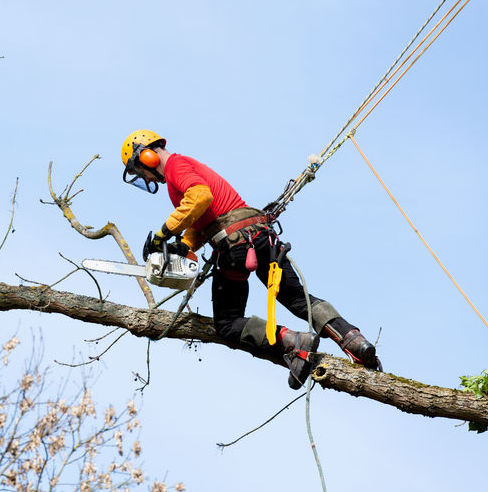24.H.02 General Practices.
- Safety, Secondary, Belay or Back-up Line(s).
- (1) Safety, Secondary, Belay or Back-up line(s) or other appropriate fall arrest devices must be used in addition to the main line (working line) unless the employer can demonstrate that the second line or other fall arrest devices would create a greater hazard or otherwise would not be feasible. > See paragraph 24.H.02.a(2).
- (2) Safety, Secondary, Belay or Back-up line(s) must not be used alone for tree climbing. The use of a secondary line (safety line) may pose additional risks and increased difficulties. Careful consideration to the impact of secondary line use should be considered before making a decision on use in tree climbing operations.
- (3) Where a safety line is used in conjunction with the working line, each line must have its own separate anchor and must be separately fixed to the worker's harness. This does not preclude both lines being attached to a single harness attachment point.
- (4) The safety line must be connected to the sternal or dorsal D-ring of the full body harness.
- (5) When using safety line, the maximum free fall distance must not exceed 6 ft (1.8 m) and the maximum arrest force must not exceed 1,800 lbs (8 kN).
- Employer must insure that anchors have been evaluated in order to ensure that overall system safety factors can be met.
- Before adopting rope access techniques for a particular job, the Competent Person (CP) for Rope Access must perform risk assessment and develop a written safety analysis report and submit it as part of the Rope Access Work Plan to GDA for acceptance. The safety analysis report must include consideration of the various rope access alternatives available and their respective access advantages and hazards. In particular, attention must be given to the following aspects:
- (1) Ability of the suspended person to safely use materials, equipment or tools necessary for the work and whether the reaction from any tool may place the person at risk;
- (2) Whether the work may loosen material which could become a hazard to the worker or others;
- (3) Whether the time required for the work at any one location will be such that there may be unacceptable levels of risk;
- (4) Whether it would be possible to quickly rescue workers that are using rope access techniques from any position they could be expected to enter.
- The contractor must make provision for prompt rescue or self rescue and for emergency services.
- The Rope Access Worker must:
- (1) Have a working understanding of the employer's Rope Access Work Plan and all applicable policy and procedures;
- (2) Adjust, inspect, maintain, care for, and properly store rope access equipment;
- (3) Inspect and verify the integrity of anchor systems and components;
- (4) Recognize worksite hazards and notify the Rope Access Supervisor of any such hazard;
- (5) Be capable of identifying work zones and job hazard analyses;
- (6) Understand and communicate any written or verbal warnings;
- (7) Be familiar with rescue procedures and systems used by the employer, and assist in the performance of rescue from rope access systems;
- (8) Utilize appropriate personal protective equipment as designated by the Rope Access Supervisor;
- (9) Follow the Competent Person (CP) for Rope Access directions or, where appropriate pursuant to the requirements of the Safe Practices Document, the Rope Access Lead Technician's directions regarding the work to be performed;
- (10) Notify the CP for Rope Access if assigned.
Knowledge Check Choose the best answer for the question.
24-10. What is the maximum free fall distance and arrest force for safety lines?
You forgot to answer the question!

